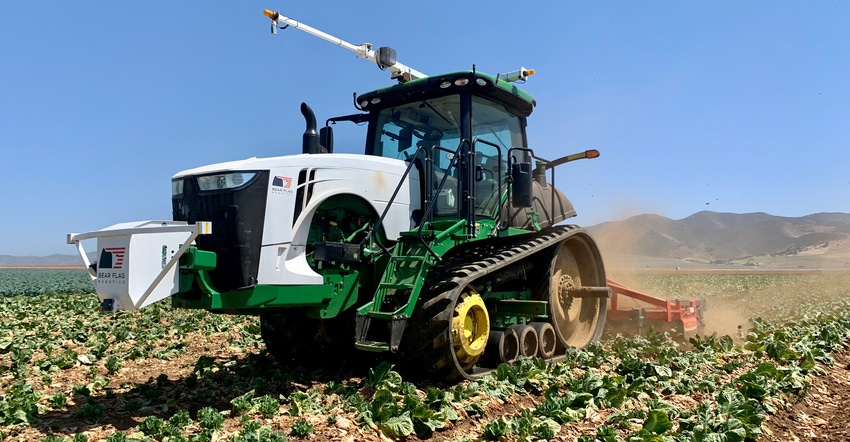
John Deere recently announced the $250 million purchase of Bear Flag Robotics, a startup company in the Silicon Valley. The startup built an autonomous solution that retrofits onto a tractor, and already has a limited number of clients for its custom tillage business using autonomous tractors, primarily in California.
If you’re not into autonomy, you might have dismissed the headline as a far-in-the-future idea. You owe it to yourself to consider comments from both companies made during a press conference the day after the sale was announced. Then decide if the idea of tractors operating on their own in widescale farming is as far-fetched as you think.
Speaking for John Deere was Dan Leibfried, director of automation and autonomy, Intelligent Solutions Group. Representing Bear Flag Robotics was Aubrey Donnellan, co-founder and chief operating officer.
What was a deciding factor in making this acquisition for you?
Leibfried: Our overall strategy is to find solutions for customers. A big challenge in farming today and tomorrow is a shortage of skilled labor. We have made great strides in automation, and we have lots of engineers working on autonomous solutions. Adding Bear Flag and their solutions and engineers helps us go farther in ag value creation.
Donnellan: We started four years ago as a group of engineers and technicians looking for solutions to challenges facing agriculture. We considered other fields to focus on, but agriculture intrigued us. Two years ago, we were one of the companies in the first class of collaborators who worked with John Deere in their new collaboration program. Our people learned a lot from that experience. Our hardware people, software people and engineers looked for a solution that didn’t just take the tractor from Point A to B without a driver, but which allowed it to work effectively at the same time.
Our first niche was retrofitting tractors to pull tillage tools autonomously in California, where tillage goes on almost all year long. We’ve proven that the concept works, and we’re excited to become a part of John Deere.
Will buying companies from the collaborator program be a trend for John Deere?
Leibfried: Someone should not read that into this acquisition. That is a good program because we can work with startup companies and learn from them while we provide guidance. In this case, the Deere and Bear Flag cultures match up very well, and they have a retrofit autonomous technology that works today. It is reality — this is just not some research and development idea.
What happens in the short term?
Leibfried: Bear Flag will retain its name for the time being and continue operating as a separate unit. We’re going to take the next six to nine months to evaluate where we go from here. Four years ago, we made the Long River acquisition, and that is now bearing fruit as we introduce See and Spray and other products.
Donnellan: We’re excited that we can continue working on other ideas. Autonomous tillage was never our end goal. It was just the first step. Now we will see where else we can apply this technology in agriculture as part of John Deere.
What does the future hold? Will it include vehicles without cabs made for autonomous operation?
Donnellan: People who see this technology work are excited. They want to know when they can get this system for their own tractor. That tells us people are ready for autonomous vehicles. We just know that we must take our time and do this right, and keep safety in mind as well.
Leibfried: We will see how things play out. The future is yet to be determined. It’s possible that we could see tractors designed for autonomy over the longer run. Those changes might be more likely over the next five to 15 years.
Donnellan: It will be interesting to see what develops when farmers are no longer confined by labor requirements. We would expect to see this technology moving into other machines besides tillage within the next five to 10 years. Eventually, it might be possible to farm with more, smaller machines.
Read more about:
AutonomousAbout the Author(s)
You May Also Like




